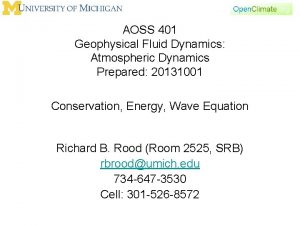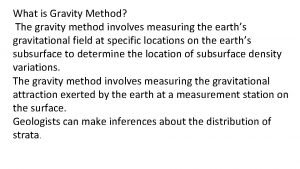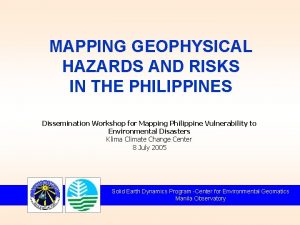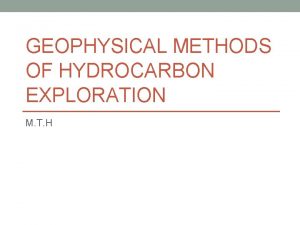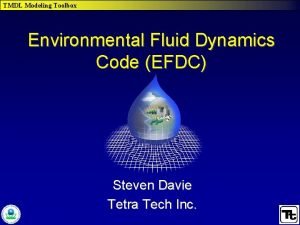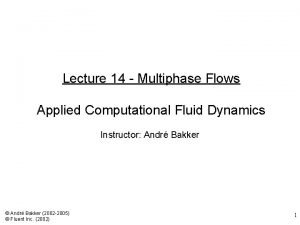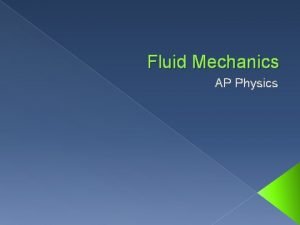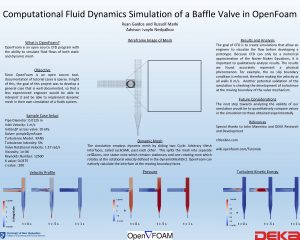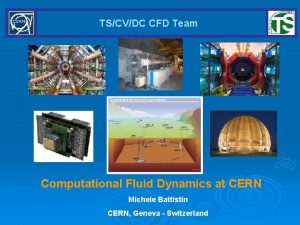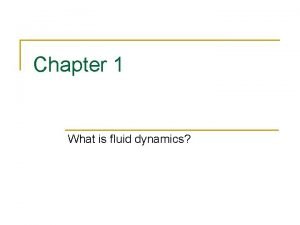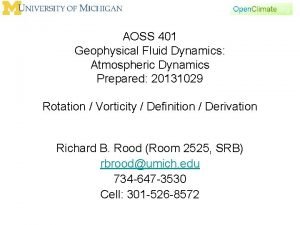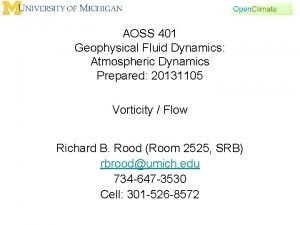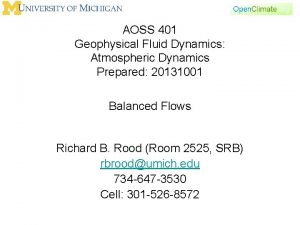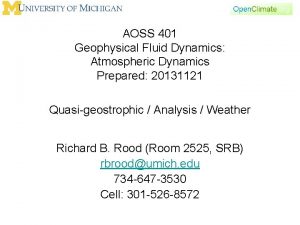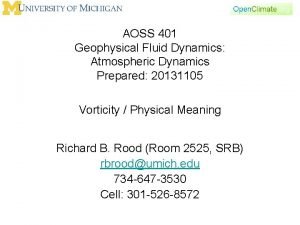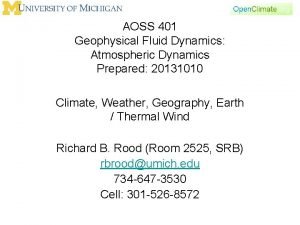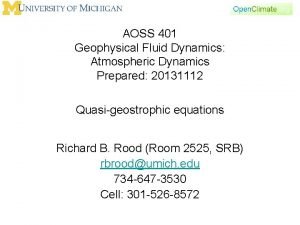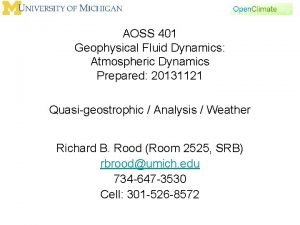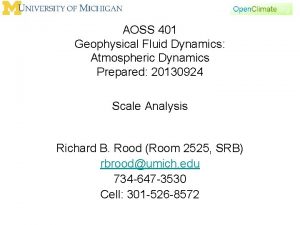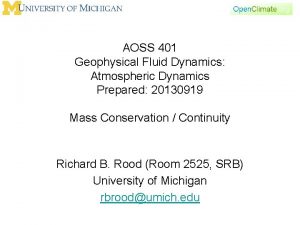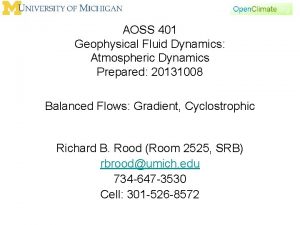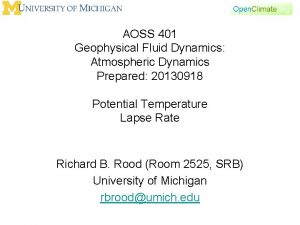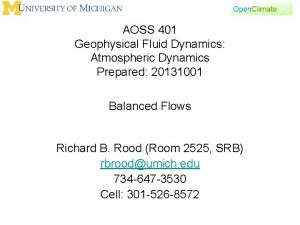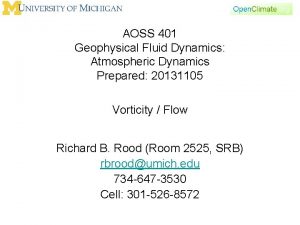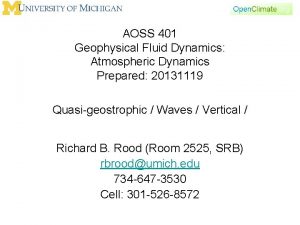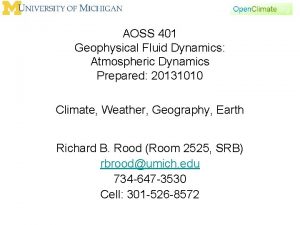AOSS 401 Geophysical Fluid Dynamics Atmospheric Dynamics Prepared






















- Slides: 22

AOSS 401 Geophysical Fluid Dynamics: Atmospheric Dynamics Prepared: 20131010 Equations of Motion in Pressure Coordinates / Thermal Wind Richard B. Rood (Room 2525, SRB) rbrood@umich. edu 734 -647 -3530 Cell: 301 -526 -8572

Class News • Ctools site (AOSS 401 001 F 13) • Second Examination on December 10, 2013 • Homework – Watch for Ctools / Email

Weather • National Weather Service – Model forecasts: • Weather Underground – Model forecasts: • NCAR Research Applications Program

Outline • Equations of Motion in Pressure Coordinates

Return to Pressure Coordinates • In the coming weeks, we will work mostly with the equations of motion in pressure coordinates • We have already derived and used extensively the horizontal momentum equations in pcoordinates • Remaining equations: – – Thermodynamic equation Continuity equation Vertical momentum equation (hydrostatic balance) Plus, what to do with the material derivative?

Our approximated horizontal momentum equations (in p coordinates) No viscosity, no metric terms, no cos-Coriolis terms Subscript h: horizontal Subscript p: constant p surfaces! Sometimes subscript is omitted, tells you that this is on p surfaces

Geostrophic Wind (in p coordinates) Component form: Vector form: Here we implicitly assume that the partial derivatives in x and y direction are computed on constant p surfaces. Advantage of the p coordinates: Simplicity of the equation! Density no longer appears explicitly.

What do we do with the material derivative? By definition: Example: Total derivative of the temperature on constant z surfaces (subscript omitted)

What do we do with the material derivative when using p in the vertical? By definition: Total derivative DT/Dt on constant pressure surfaces: (subscript omitted)

Think about vertical motion in pressure coordinates • For upward motion, what is the sign of ‘w’ (vertical velocity in height coordinates)? • What is the sign of ω for upward vertical motion? Remember: • And pressure decreases with height… • What is the sign of Dp/Dt (change in pressure following the motion) for upward motion? For downward motion?

Think about vertical motion in pressure coordinates • Something to keep in the back of your mind… • ω is negative for upward motion • ω is positive for downward motion

Thermodynamic equation (in p coordinates) From Holton, we can Derive two forms of thermodynamic equation Expand the material derivative and use

Thermodynamic equation (in p coordinates) Collect terms in ω and divide through by cp Use the equation of state (ideal gas law)

Thermodynamic equation (in p coordinates) Define the static stability parameter Sp What is static stability?

Thermodynamic equation (in p coordinates) If there is no horizontal advection, then the time rate of change of temperature is due to…? Adiabatic rising/sinking Diabatic heating (radiation, condensation) http: //www. wunderground. com/modelmaps/maps. asp? model=NAM&domain=US

Continuity equation in z coordinates: in p coordinates: We could try to derive the pressure-coordinate version from the height-coordinate equation (as we did with the pressure gradient force in the horizontal momentum equations), but…

Re-deriving the continuity equation in p coordinates It turns out to be easier to re-derive it from mass conservation Start with an air parcel with volume: V= x y z z Apply the hydrostatic y x equation p= - g z to express the volume element as V= - x y p/( g) The mass of this fluid element is: M = V= - x y p/( g) = - x y p/g

Re-deriving the continuity equation in p coordinates z ( M = - x y p/g) x y Use the product rule Differential calculus Take the limit Continuity equation in p coordinates

Continuity equation(in p coordinates) This form of the continuity equation contains no reference to the density field and does not involve time derivatives. The simplicity of this equation is one of the chief advantages of the isobaric system. Ease of computing vertical motion from convergence/divergence is another…

Hydrostatic equation (in p coordinates) Hydrostatic equation in z-coords Rearrange (and assume g constant) Apply the equation of state Replaces the vertical momentum equation

Approximated equations of motion in pressure coordinates

In the derivation of the equations in pressure coordinates: • Have used conservation principles. • Have relied heavily on the hydrostatic assumption. • Required that conservation principles hold in all coordinate systems. • Plus we did some implicit scaling (metric terms, cosine coriolis terms dropped out).
 Geophysical fluid dynamics
Geophysical fluid dynamics Reservoir geophysical corporation
Reservoir geophysical corporation Gravity method of geophysical exploration
Gravity method of geophysical exploration Philippine geophysical hazard map
Philippine geophysical hazard map National geophysical data center
National geophysical data center Gravity method of geophysical exploration
Gravity method of geophysical exploration Fluid statics deals with
Fluid statics deals with Define fluid kinematics
Define fluid kinematics Transcellular fluid compartment
Transcellular fluid compartment Movement of body fluids
Movement of body fluids Is synovial fluid extracellular fluid
Is synovial fluid extracellular fluid Bioimpedância
Bioimpedância Paracentesis for ascites
Paracentesis for ascites P1-p2
P1-p2 Hypoosmotic
Hypoosmotic Computational fluid dynamics
Computational fluid dynamics Environmental fluid dynamics code
Environmental fluid dynamics code Computational fluid dynamics
Computational fluid dynamics Fluid dynamics
Fluid dynamics Openfoam baffle
Openfoam baffle Maysam mousaviraad
Maysam mousaviraad Fluid dynamics definition
Fluid dynamics definition Colloid osmotic pressure
Colloid osmotic pressure
